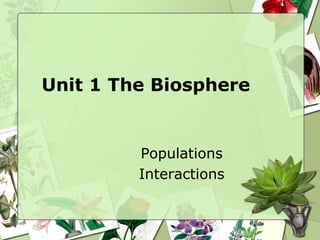
Unit 1 the biosphere populations and interactions
- 1. Unit 1 The Biosphere Populations Interactions
- 2. 3 Properties of Populations • Population Size • Population Density • Population Dispersion
- 3. Population Size • Population-groups of organisms that belong to the same species and live in a particular area at one time • Population size-number of individuals a population has • Sometimes there are too many to count so a sampling is used. • Scientists count a number of organisms in a certain area and multiply the area.
- 4. Population Density • Population density-measures how crowded a population is • The number is always expressed as the number of individuals per unit of area or volume • Some areas are densely populated and others are sparsely populated
- 5. Population Dispersion • Dispersion is the spatial distribution of individuals within a population. • There are three types of dispersion. • Clumped dispersion occurs because resources and living space is clumped or because of behavior, herding • Even dispersion is the result of social behavior and organisms stay as far away from each other as possible • Random dispersion results from wind distribution of seeds so plants usually have a random dispersal
- 7. Population Dynamics • All populations are dynamic, meaning they change in size and composition over time. • Birth rate-number of births over time • Death rate (mortality rate)- number of deaths over time • Life expectancy- how long on average an individual is expected to live
- 8. Age Structure • Age structure-distribution of individuals among different ages in a population • Different countries have different age structures. • We can use graphs to compare age structure.
- 14. Population Growth Rate • Growth rate- the amount by which a population’s size changes over time • Immigration-individuals moving into a population • Emigration-individuals moving out of a population
- 15. Exponential Growth Model • Exponential Model- population increases rapidly after only a few generations; the larger the population gets, the faster it grows • Limiting factor-a factor that restrains or stops the growth of a population • Limiting factors are available resources, space, waste accumulation, population density
- 17. Logistic Growth Model • Logistic model-builds on the exponential model but adds the limiting factors. • Carrying capacity (K)- the number of individuals the environment can support over a long period of time • Once carrying capacity is reached, the population remains constant
- 19. Population Regulation • Density-independent factors- weather, flood, fires; these reduce the population regardless of size • Density-dependent factors- food, nesting sites, illness; these occur as a result of population size
- 20. Perils of small populations- Inbreeding • The rapidly growing human population has caused extreme reductions in the populations of some other species and subspecies. • Fewer than 200 Siberian tigers remain in the wild due to over hunting and habitat destruction • The California condor is down to 9 individuals. • Fewer individuals means inbreeding or mating with relatives. • This mean the babies will be more likely to have defects or diseases.
- 21. Predation •Predator-captures, kills and consumes another individual •Prey-is captured and consumed for food
- 22. Predators, Prey and Natural Selection • A predator’s survival depends on its ability to capture food, but a prey’s survival depends on its ability to avoid being captured.
- 23. Mimicry • Deception is important in antipredator defenses. • In a defense called mimicry, a harmless species resembles a poisonous or distasteful species. • The harmless mimic is protected because it is often mistaken to be its dangerous look-alike
- 26. National Geographic’s Collection of Mimicry and Camouflage
- 37. Plant-Herbivore Interactions • Animals that eat plants are called herbivores. • Through natural selection, plants have evolved adaptations that protect them from being eaten. • Physical defenses, such as sharp thorns, spines, sticky hairs, and tough leaves, can make a plant more difficult to eat.
- 39. Plant-Herbivore Interactions • Plants have also evolved a range of chemical defenses. • They synthesize chemicals from products of their metabolism, called secondary compounds, that are poisonous, irritating, or bad tasting. • Examples are the tobacco plant and poison ivy and poison oak. • Many medicines are derived from secondary compounds.
- 42. Parasitism • Parasitism- a species interaction that resembles predation in that one individual is harmed while the other benefits • Parasite- feeds on another individual, harming it • Host-fed upon by another organism • Ectoparasites-external, ticks, fleas, lice • Endoparasites-internal, worms, protists
- 43. Ectoparasites
- 44. Endoparasites
- 45. Competition • Competition results from niche overlap. • Competition is the use of the same limited resource by two or more species. • Competitive exclusion is when one species is eliminated from a community due to competition. • One species uses a resource more efficiently and has a reproductive advantage over the other. • Competition is the most intense between similar species using the same resources.
- 46. Mutualism and Commensalism • Mutualism- a cooperative relationship in which both partners benefit • Some mutualistic relationships are so close that neither partner could live without the other. • Pollination is a major mutualistic relationship that benefits the world.
- 47. Mutualism and Commensalism • Commensalism- a relationship between organisms in which one organism benefits and one organism is unaffected. • One example is birds eating insects and lizards that are flushed out by buffalo. • The buffalo is not harmed and does not benefit but the birds clearly benefit from the buffalo.
- 48. Mutualism
- 49. CommensalismThese are mainly commensalism but could change to mutualism if the situation changes.
- 50. Commensalism
- 51. Mutualism
- 52. commensalism
- 53. Parasitism
- 54. Predation
- 55. Parasitism
- 56. mutualism
- 57. mutualism
